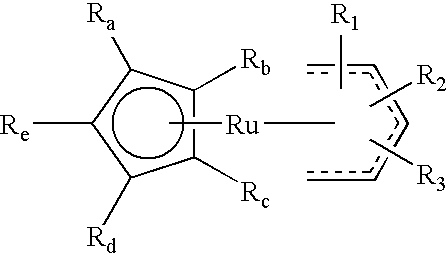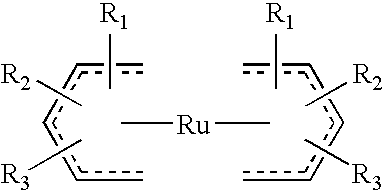High nucleation density organometallic compounds
a technology of organometallic ruthenium compounds which is applied in the direction of group 3/13 element organic compounds, liquid/solution decomposition chemical coatings, organic chemistry, etc., can solve the problems of low thermal stability, difficult to achieve high growth rates during film deposition, and complicate processing, etc., to achieve high nucleation density, high nucleation density, and high nucleation density
- Summary
- Abstract
- Description
- Claims
- Application Information
AI Technical Summary
Benefits of technology
Problems solved by technology
Method used
Image
Examples
example 1
Synthesis of (1,3-dimethylcyclopentadienyl)(2,4-dimethylpentadienyl)ruthenium
[0125]A dry 1 liter 3-neck round-bottom flask was charged with a magnetic stir bar and equipped with three septa. A nitrogen purge was introduced through a needle with output, also via a needle, to an oil bubbler. A thermocouple lead was placed through a side neck septa. Excess zinc (150 grams, ‘dust’ was found more conducive to stirring) was added to the flask. By syringe, 2,4-dimethyl-1,3-pentadiene (25 grams, 0.26 mol) was added to the flask. By cannula, ruthenium trichloride hydrate (6.0 grams, 0.023 mol based on 3 hydrate equivalents) was added as a methanol (250 milliliters) solution in spurts of about 10 milliliters over 45 minutes. The mixture was stirred for 30 minutes at 25° C. after the addition was complete, then, upon equipping a condenser, the contents were brought to gentle reflux. Stirring was continued for 2 hours. The mixture was cooled to 25° C., followed by the addition of freshly distil...
example 2
Synthesis of (1,3-dimethylcyclopentadienyl)(2,4-dimethylpentadienyl)ruthenium
[0128]A 2 liter three-necked round bottomed flask is charged with a Teflon7 stirring bar, ethanol (1.0 liter) and PPh3 (263 grams, 1.0 mol). A 250 milliliter dropping funnel, a 150 milliliter bath-jacketed dropping funnel, and a condenser are attached to the three necks of the 2 liter flask. It is important to note that both dropping funnels are equipped with Teflon7 valves that permit their isolation from the atmosphere of the round-bottomed flask. A rubber septum is connected to the top of the 150 milliliter bath-jacketed dropping funnel. The top of the condenser is fitted with a T junction adapter and connected to an inert atmosphere. A heating mantle is placed beneath the 2 liter, three-necked round-bottomed flask and the solution is stirred and heated to reflux. At reflux, all of the triphenylphosphine dissolves in the ethanol. The system is purged with nitrogen for 3 hours while at reflux.
[0129]While ...
PUM
| Property | Measurement | Unit |
|---|---|---|
| temperature | aaaaa | aaaaa |
| temperature | aaaaa | aaaaa |
| temperature | aaaaa | aaaaa |
Abstract
Description
Claims
Application Information
 Login to View More
Login to View More - R&D
- Intellectual Property
- Life Sciences
- Materials
- Tech Scout
- Unparalleled Data Quality
- Higher Quality Content
- 60% Fewer Hallucinations
Browse by: Latest US Patents, China's latest patents, Technical Efficacy Thesaurus, Application Domain, Technology Topic, Popular Technical Reports.
© 2025 PatSnap. All rights reserved.Legal|Privacy policy|Modern Slavery Act Transparency Statement|Sitemap|About US| Contact US: help@patsnap.com



